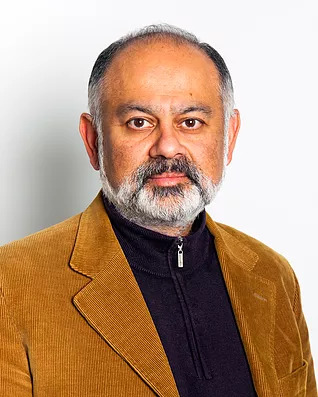About Professor Kalia

Professor Yogeshvar N. Kalia is a full professor at the University of Geneva.
After a B.Sc. (Hons.) degree in Chemistry, he obtained a Ph.D. in physical chemistry (speciality: development of enzyme electrodes) at the Imperial College of Science, Technology & Medicine, UK. The main focus of the research was the development of enzyme electrodes and an investigation into the mechanisms of electron transfer at the enzyme-electrode interface. This was followed by a three year postdoctoral fellowship in the Dept. of Biochemistry at the University of Cambridge (speciality: protein structure determination); two-dimensional NMR techniques were used to determine the structure of a protein subunit-binding domain. Since 1994, he has worked in biopharmaceutics (speciality: transdermal drug delivery), first at the University of California - San Francisco and since 1997 at the University of Geneva.
He has published 190 papers with 109 as corresponding author – (i) Scopus, h-index 57 and 11,111 citations, (ii) Google Scholar, h-index 65 and 15,764 total citations – 21 book chapters and ~220 communications at national / international conferences and I am a co-inventor on 7 patents.. He serves on the Editorial Boards of the European Journal of Pharmaceutics and Biopharmaceutics, Expert Opinion on Drug Delivery, International Journal of Pharmaceutics, Pharmaceutics, Sci, and Scientia Pharmaceutica.
Education details
- 1984-87
-
B.Sc. Hons. (First Class) in Chemistry
ARCS (Associateship of the Royal College of Science) Imperial College of Science, Technology and Medicine; University of London, UK - 1987-90
-
Ph.D. & DIC (Diploma of Imperial College)
Department of Chemistry; Imperial College of Science, Technology and Medicine; University of London, UK
Project: "Development of Enzyme Electrodes" (Advisor: Prof. W.J. Albery FRS)
- Development of biosensors using conducting organic salt enzyme electrodes.
- Multienzyme-electrochemical sensors for measuring sucrose, xanthine/hypoxanthine and creatine.
- Elucidation of the mechanism of action of conducting organic salt enzyme electrodes by using electrochemical methods including rotating disk and ring/disk techniques, chronoamperometry, cyclic voltammetry and impedance spectroscopy
Career details
- 1990-1993
-
Postdoctoral Research Associate
Cambridge Centre for Molecular Recognition, Department of Biochemistry, University of Cambridge, UK
Project:
Determination of the three-dimensional structure (using 2D-NMR and simulated annealing) of the dihydrolipoamide dehydrogenase(E3)/pyruvate decarboxylase (E1p) binding domain from the pyruvate dehydrogenase multienzyme complex from Bacillus stearothermophilus. - 1994-1996
-
Postdoctoral Research Fellow
Departments of Biopharmaceutical Sciences and Pharmaceutical Chemistry, University of California – San Francisco, USA
Projects:
- Characterization of molecular transport across the skin in vivo: Low frequency impedance spectroscopy and transepidermal water loss used to investigate water diffusion across human skin in vivo and to show that the structurally heterogeneous stratum corneum behaves as a homogenous barrier to water transport.
- Structure-transport relationships governing iontophoretic drug delivery: LHRH analogs used as model oligopeptides to identify structural motifs that modulate drug delivery.
- Effects of iontophoresis on human skin in vivo: Low frequency skin impedance spectroscopy used to establish the effect of iontophoresis and the interaction between chemical and electrical methods of enhancing drug delivery in human skin in vivo.
- Assessment of skin barrier development in premature infants (Clinical study with the Intensive Care Unit at Children's Hospital Oakland): Impedance spectroscopy and transepidermal water loss measurements used to investigate the development of barrier function in low birth weight neonates in vivo.
- 1997-2001
-
Maître Assistant
Section de Pharmacie, Université de Genève Projects:
- Structure-transport relationships in iontophoresis: Identification of key experimental parameters and structure-transport relationships governing iontophoretic transdermal drug administration.
- Evaluation and optimization of topical drug bioavailability in vivo: Non-invasive biophysical techniques (low frequency impedance spectroscopy, transepidermal water loss, attenuated total reflectance Fourier Transform infra-red spectroscopy) used in conjunction with tape-stripping methodology to evaluate the effect of drug formulation on skin barrier function and drug permeability and to assess topical drug bioavailability of lipophilic molecules.
- Modeling transdermal drug delivery: Development of mathematical models to calculate diffusion parameters describing drug transport across the skin in vivo.
- Sonophoresis: Assessment of the effects and mechanisms underlying sonophoretic enhancement of transdermal delivery.
- Development of drug delivery technologies for premature neonates: Development of barrier models to mimic the impaired skin barrier function in premature neonates and hence optimize drug delivery and noninvasive clinical monitoring in this population.
- 2001-2013
-
Maître d’Enseignement et de Recherche
(Senior Lecturer)
Section des Sciences Pharmaceutiques, Université de Genève
Projects:- Develop new formulations to increase local and systemic bioavailability of topical and transdermal therapeutics: The aim is to investigate alternatives to exisitng patch-based dosage forms and to explore the potential applications of "nanotechology" to improve delivery of pharmaceuticals and cosmeceuticals into and across the skin.
- Investigate new technologies for the non- and minimally-invasive delivery of biotechnology derived therapeutics across the skin: Peptide and protein therapeutics are routinely administered parenterally. We have recently shown that it is possible to deliver intact, functional proteins non-invasively across the skin (Cytochrome c and Ribonuclease A). A pioneering laser-based technology has been used to demonstrate the feasibility of delivering larger proteins (upto 70 kDa).
- Determine the effect of molecular properties on transdermal iontophoretic delivery: The objective is to identify the effect of molecular properties and their spatial distribution on the iontophoretic transport of small molecules, peptides and proteins.
- Synthesis and characterisation of prodrugs optimised for transdermal delivery: Chemically modified agents with improved physicochemical properties that facilitate transport across the skin.
- 2014-
-
Professeur Associé
(Associate Professor)
Section des Sciences Pharmaceutiques, Université de Genève
Main research interests:- Development of new formulations to increase local and systemic bioavailability of topical and transdermal therapeutics.
- Investigation of the influence of physicochemical properties on electrically-assisted transport across the skin.
- Synthesis and characterization of prodrugs optimized for transdermal iontophoretic administration.
- Development of new techniques for the “needle-less” delivery of biotechnology-derived therapeutics across the skin (“pharmaceutical biotechnology”).
- Investigation into the use of formulation and technology-based methods to improve buccal and ocular drug delivery.
- Developing a physiological model for drug permeation in the gastrointestinal tract in vitro.